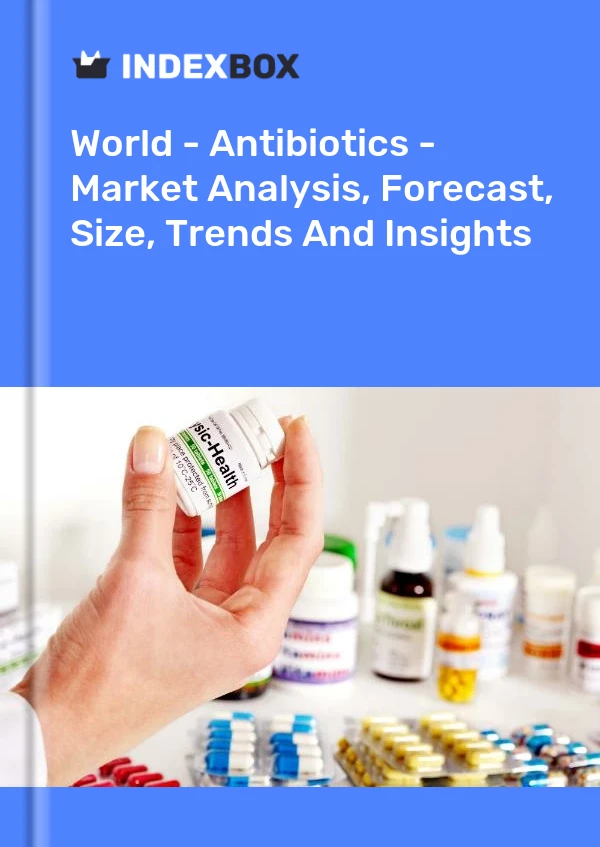
World - Antibiotics - Market Analysis, Forecast, Size, Trends And Insights
Get instant access to more than 2 million reports, dashboards, and datasets on the IndexBox Platform.
View PricingFeeding Antibiotics to Livestock
Feeding antibiotics to livestock is a common practice in modern agriculture. It involves administering antibiotics to farm animals, particularly poultry, swine, and cattle, through their feed or water. The main reasons for feeding antibiotics to livestock are to promote growth and prevent disease outbreaks.
Antibiotics can promote growth in livestock by altering their gut microbiota. They reduce the population of harmful bacteria in the animals' intestines, allowing them to extract more nutrients from their feed and utilize them for growth. Additionally, certain antibiotics have been found to have direct growth-enhancing effects in animals.
Moreover, feeding antibiotics to livestock helps prevent the spread of infectious diseases. When animals are raised in overcrowded and stressful conditions, such as in concentrated animal feeding operations (CAFOs), they are more susceptible to infections. Antibiotics can be administered prophylactically to prevent the occurrence and transmission of diseases within the herd or flock.
However, the use of antibiotics in livestock production is a controversial topic due to several concerns. One major concern is the development of antibiotic resistance. When antibiotics are continuously fed to animals, bacteria can develop resistance to them. These resistant bacteria can then be transmitted to humans through the consumption of contaminated meat or through direct contact with animals or their environment.
Another concern is the potential presence of antibiotic residues in animal products. The use of antibiotics in livestock production is regulated, and withdrawal periods are established to ensure that no antibiotic residues are present in the meat, milk, or eggs consumed by humans. However, non-compliance and inadequate monitoring can lead to the presence of residues, which can have adverse effects on human health.
The use of antibiotics in livestock production also raises ethical concerns. Some argue that the widespread use of antibiotics in agriculture contributes to the overuse and misuse of antibiotics, which can have long-term consequences for human health. It can also lead to the confinement and mistreatment of animals in intensive farming operations.
To address these concerns, regulations and guidelines have been implemented to promote responsible use of antibiotics in livestock production. These include the prudent use of antibiotics under veterinary supervision, adherence to withdrawal periods, and the development of alternative strategies such as improved hygiene, vaccination, and the use of probiotics and prebiotics.
In conclusion, feeding antibiotics to livestock is a common practice to promote growth and prevent diseases. However, it raises concerns regarding antibiotic resistance, antibiotic residues, and animal welfare. Responsible use of antibiotics and the adoption of alternative strategies are important for ensuring sustainable and safe livestock production.
This report provides an in-depth analysis of the global antibiotic market. Within it, you will discover the latest data on market trends and opportunities by country, consumption, production and price developments, as well as the global trade (imports and exports). The forecast exhibits the market prospects through 2030.
Product coverage:
- Prodcom 21105400 - Antibiotics
Country coverage:
Worldwide - the report contains statistical data for 200 countries and includes detailed profiles of the 50 largest consuming countries:
- USA
- China
- Japan
- Germany
- United Kingdom
- France
- Brazil
- Italy
- Russian Federation
- India
- Canada
- Australia
- Republic of Korea
- Spain
- Mexico
- Indonesia
- Netherlands
- Turkey
- Saudi Arabia
- Switzerland
- Sweden
- Nigeria
- Poland
- Belgium
- Argentina
- Norway
- Austria
- Thailand
- United Arab Emirates
- Colombia
- Denmark
- South Africa
- Malaysia
- Israel
- Singapore
- Egypt
- Philippines
- Finland
- Chile
- Ireland
- Pakistan
- Greece
- Portugal
- Kazakhstan
- Algeria
- Czech Republic
- Qatar
- Peru
- Romania
- Vietnam
+ the largest producing countries
Data coverage:
- Global market volume and value
- Per Capita consumption
- Forecast of the market dynamics in the medium term
- Global production, split by region and country
- Global trade (exports and imports)
- Export and import prices
- Market trends, drivers and restraints
- Key market players and their profiles
Company coverage:
Reasons to buy this report:
- Take advantage of the latest data
- Find deeper insights into current market developments
- Discover vital success factors affecting the market
This report is designed for manufacturers, distributors, importers, and wholesalers, as well as for investors, consultants and advisors.
In this report, you can find information that helps you to make informed decisions on the following issues:
- How to diversify your business and benefit from new market opportunities
- How to load your idle production capacity
- How to boost your sales on overseas markets
- How to increase your profit margins
- How to make your supply chain more sustainable
- How to reduce your production and supply chain costs
- How to outsource production to other countries
- How to prepare your business for global expansion
While doing this research, we combine the accumulated expertise of our analysts and the capabilities of artificial intelligence. The AI-based platform, developed by our data scientists, constitutes the key working tool for business analysts, empowering them to discover deep insights and ideas from the marketing data.
-
1. INTRODUCTION
Making Data-Driven Decisions to Grow Your Business
- REPORT DESCRIPTION
- RESEARCH METHODOLOGY AND AI PLATFORM
- DATA-DRIVEN DECISIONS FOR YOUR BUSINESS
- GLOSSARY AND SPECIFIC TERMS
-
2. EXECUTIVE SUMMARY
A Quick Overview of Market Performance
- KEY FINDINGS
- MARKET TRENDS This Chapter is Available Only for the Professional Edition PRO
-
3. MARKET OVERVIEW
Understanding the Current State of The Market and Its Prospects
- MARKET SIZE
- CONSUMPTION BY COUNTRY
- MARKET FORECAST TO 2030
-
4. MOST PROMISING PRODUCT
Finding New Products to Diversify Your Business
This Chapter is Available Only for the Professional Edition PRO- TOP PRODUCTS TO DIVERSIFY YOUR BUSINESS
- BEST-SELLING PRODUCTS
- MOST CONSUMED PRODUCT
- MOST TRADED PRODUCT
- MOST PROFITABLE PRODUCT FOR EXPORT
-
5. MOST PROMISING SUPPLYING COUNTRIES
Choosing the Best Countries to Establish Your Sustainable Supply Chain
This Chapter is Available Only for the Professional Edition PRO- TOP COUNTRIES TO SOURCE YOUR PRODUCT
- TOP PRODUCING COUNTRIES
- TOP EXPORTING COUNTRIES
- LOW-COST EXPORTING COUNTRIES
-
6. MOST PROMISING OVERSEAS MARKETS
Choosing the Best Countries to Boost Your Exports
This Chapter is Available Only for the Professional Edition PRO- TOP OVERSEAS MARKETS FOR EXPORTING YOUR PRODUCT
- TOP CONSUMING MARKETS
- UNSATURATED MARKETS
- TOP IMPORTING MARKETS
- MOST PROFITABLE MARKETS
7. GLOBAL PRODUCTION
The Latest Trends and Insights into The Industry
- PRODUCTION VOLUME AND VALUE
- PRODUCTION BY COUNTRY
8. GLOBAL IMPORTS
The Largest Importers on The Market and How They Succeed
- IMPORTS FROM 2012–2023
- IMPORTS BY COUNTRY
- IMPORT PRICES BY COUNTRY
9. GLOBAL EXPORTS
The Largest Exporters on The Market and How They Succeed
- EXPORTS FROM 2012–2023
- EXPORTS BY COUNTRY
- EXPORT PRICES BY COUNTRY
-
10. PROFILES OF MAJOR PRODUCERS
The Largest Producers on The Market and Their Profiles
This Chapter is Available Only for the Professional Edition PRO -
11. COUNTRY PROFILES
The Largest Markets And Their Profiles
This Chapter is Available Only for the Professional Edition PRO- United States
- China
- Japan
- Germany
- United Kingdom
- France
- Brazil
- Italy
- Russian Federation
- India
- Canada
- Australia
- Republic of Korea
- Spain
- Mexico
- Indonesia
- Netherlands
- Turkey
- Saudi Arabia
- Switzerland
- Sweden
- Nigeria
- Poland
- Belgium
- Argentina
- Norway
- Austria
- Thailand
- United Arab Emirates
- Colombia
- Denmark
- South Africa
- Malaysia
- Israel
- Singapore
- Egypt
- Philippines
- Finland
- Chile
- Ireland
- Pakistan
- Greece
- Portugal
- Kazakhstan
- Algeria
- Czech Republic
- Qatar
- Peru
- Romania
- Vietnam
-
LIST OF TABLES
- Key Findings In 2023
- Market Volume, In Physical Terms, 2012–2023
- Market Value, 2012–2023
- Per Capita Consumption, By Country, 2018–2023
- Production, In Physical Terms, By Country, 2012–2023
- Imports, In Physical Terms, By Country, 2012–2023
- Imports, In Value Terms, By Country, 2012–2023
- Import Prices, By Country Of Destination, 2012–2023
- Exports, In Physical Terms, By Country, 2012–2023
- Exports, In Value Terms, By Country, 2012–2023
- Export Prices, By Country Of Origin, 2012–2023
-
LIST OF FIGURES
- Market Volume, In Physical Terms, 2012–2023
- Market Value, 2012–2023
- Consumption, By Country, 2023
- Market Volume Forecast to 2030
- Market Value Forecast to 2030
- Products: Market Size And Growth, By Type
- Products: Average Per Capita Consumption, By Type
- Products: Exports And Growth, By Type
- Products: Export Prices And Growth, By Type
- Production Volume And Growth
- Exports And Growth
- Export Prices And Growth
- Market Size And Growth
- Per Capita Consumption
- Imports And Growth
- Import Prices
- Production, In Physical Terms, 2012–2023
- Production, In Value Terms, 2012–2023
- Production, By Country, 2023
- Production, In Physical Terms, By Country, 2012–2023
- Imports, In Physical Terms, 2012–2023
- Imports, In Value Terms, 2012–2023
- Imports, In Physical Terms, By Country, 2023
- Imports, In Physical Terms, By Country, 2012–2023
- Imports, In Value Terms, By Country, 2012–2023
- Import Prices, By Country, 2012–2023
- Exports, In Physical Terms, 2012–2023
- Exports, In Value Terms, 2012–2023
- Exports, In Physical Terms, By Country, 2023
- Exports, In Physical Terms, By Country, 2012–2023
- Exports, In Value Terms, By Country, 2012–2023
- Export Prices, 2012–2023
Discover the top import markets for antibiotics across the world, including India, Italy, Germany, and the United States. Gain insights into key statistics and market dynamics in these countries. IndexBox Market Intelligence platform provides accurate and up-to-date data for informed decision-making.
In 2016, the global antibiotic imports stood at X tons, reducing by -X% against the previous year level. Overall, antibiotic imports continue to indicate a temperate setback. The pace of growt...
In 2016, the global antibiotic imports stood at X tons, reducing by -X% against the previous year level. Overall, antibiotic imports continue to indicate a temperate setback. The pace of growt...
The global trade in antibiotics amounted to X million USD in 2015, showing some fluctuations over the period under review. A slight decline in 2009 was followed by a peak in 2011, until exports decreased again. Overall
China is one of the largest global producers and consumers of antibiotics. In 2014, China exported X% of its total antibiotics output. Of this amount, X% was supplied to India, where Chinese antibiotics held a X% share of total India's consumption
Switzerland is one of the leaders in the global antibiotics trade. However, in 2014, Switzerland exported X tons of antibiotics totaling X billion USD, a full X% under the previous year. Its primary trading partner was Germany, where it suppli











































